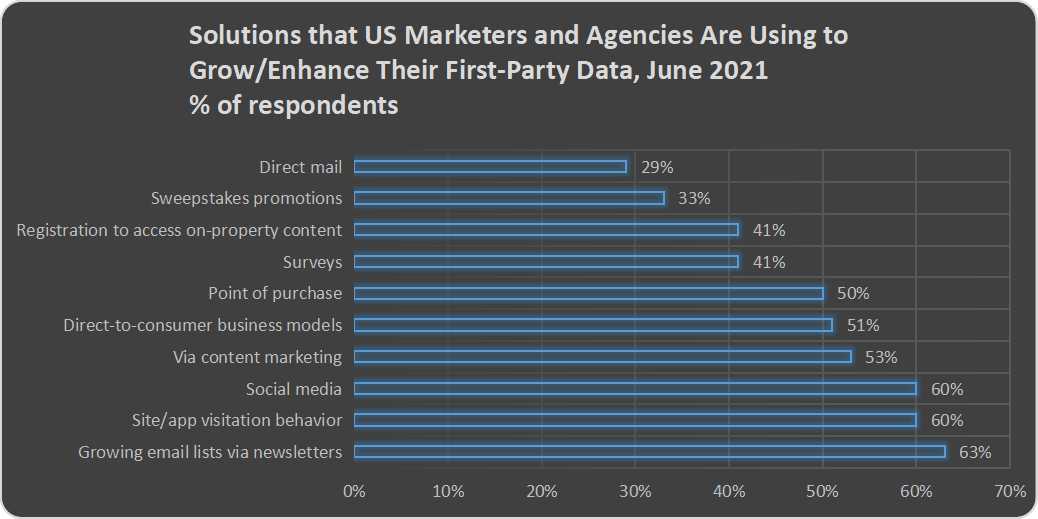The Data Dichotomy: How To Use and Protect Your First-Party Data To Drive Mobile Marketing
Data marketing is experiencing a push/pull dichotomy, how can they use their data assets while protecting them well to improve marketing performance?
Oct 25 2022
Home  ASA Blogs
ASA Blogs
 ASA Blogs
ASA Blogs Data marketing is currently experiencing a push/pull dichotomy: data is growing more valuable and important while also becoming more difficult to gather.
For marketers, this friction is challenging to maneuver. So how can they make the most of all of their data assets while preventing it from getting into the wrong hands in order to improve marketing performance?

Winning the consumer experience online, however, presents a very different challenge than in the past. Customers have stated a desire for more individualized brand experiences that take into account their past purchasing patterns and declared interests. Marketers need robust and unique data to accomplish that.
Bottom line: Customers won't pay attention to or buy from brands that don't live up to their greater expectations.
This urgent problem is highlighted in a recent Interactive Advertising Bureau study, which quotes IAB's Angelina Eng as saying, "If we don't broaden our approach to the market, soon we'll be functioning by the equivalent of darkness."
The bottom line: To resist data deprecation tendencies and maintain your team data-rich, you need a fully developed data-collection program.
First-party data, however, is predicted to be the future of data-driven marketing. 53 percent of marketing businesses in one research said they were increasing their spending on 1st-party data to keep up with the evolving data landscape. In another, 61% of fast-growing businesses are implementing a first-party data strategy.

PII is gathered and used by marketers to conduct highly focused and customized promotions, which can make the difference between successful and unsuccessful campaigns.
However, employing it requires professionals to handle it carefully. Even exchanging it between spouses calls for meticulous "clean rooms" to keep it secure. Additionally, the government has the power to penalise some companies for breaking the regulations, including the pharmaceutical/healthcare and financial services sectors, for how they protect customer data.
Brands must secure PII due to how sensitive customers are - and rightly should be - to data breaches, in addition to the enormous responsibility of protecting consumers. It's difficult to avoid the conclusion that some of the largest PII breaches in history are directly to blame for the significant increase in consumer data monitoring that has led to the difficulties marketers are currently experiencing.
Marketers can use both their own and third parties' performance data to increase marketing success. A campaign may be impacted by numerous people from within a company and from different marketing technology platforms, both native and third-party.
Even while this data is undoubtedly less secure than the safeguards in place to protect consumer PII, a brand risking being outmaneuvered by its own stolen metrics in the highly competitive marketing environment of today.
Retailers or publishers may potentially use data on product sales or ad performance to develop new private label products, which would ultimately reduce the company's market share. Key competitive advantages that must be safeguarded include knowledge of what is and is not selling, what pricing points work, which options and selections drive average order values, etc.
How much does the private label industry influence name brands, and how big is it? The impact of only one retailer-owned private label brand, Costco's Kirkland, is highlighted in the 2019 Forbes.com article 4 Reasons CPG Brands Are Losing Out To Retailers' Private Labels:
The Kirkland brand was created by Costco in 1992, which is 27 years ago. Last year, Kirkland generated $39 billion in sales, compared to $26 or $27 billion for all Kraft and Heinz brands. So here they are, more than a century old, with a ton of advertising, ingrained in people's routines, and now Kirkland, a private label brand, appears and, with only 750 or so stores, outperforms all Kraft-Heinz brands in terms of sales.

But the other brands on the grocery store's aisle aren't always today's rivals.
It's crucial to keep in mind that many companies even engage in direct competition in some markets with the publishers that receive millions of dollars from them annually. There is therefore no motivation to offer any further information unless it directly contributes to marketing ROI, even though these publishers have access to many marketing indicators.
Additionally, publishers are allowing businesses to enter their walls with an increasing amount of their first-party data. Publishers may be able to more effectively target and optimize ad distribution on behalf of their brands by sharing this confidential IP.
For instance, conversion data that publisher pixels can't track can provide publisher algorithms a better line of sight to link customers with advertising and eventually produce greater ROI for those businesses.
But what do these brands sacrifice in exchange for this performance advantage? The future? However, if intellectual property is so effective that it can influence financial outcomes, then it undoubtedly has the ability to benefit others.
How do you deal with the data dichotomy?
We allows you to protect your most valuable asset and makes it even more potent by bringing your data closer to your activation. In addition, our best-in-class capabilities prevent your data from being exposed to publishers or competitors.
The importance of first-party data in the marketing process needs no further emphasis. Having the data secure and making the most of it is a necessary prerequisite for a successful marketing campaign.
For marketers, this friction is challenging to maneuver. So how can they make the most of all of their data assets while preventing it from getting into the wrong hands in order to improve marketing performance?

What is Marketing Data Dichotomy?
The Push: To succeed, a strong data program is required
Leaders in marketing understand the importance of data in making wise decisions. However, the stakes have raised. Due to the pandemic, online advertising and trade are now more competitive than ever.Winning the consumer experience online, however, presents a very different challenge than in the past. Customers have stated a desire for more individualized brand experiences that take into account their past purchasing patterns and declared interests. Marketers need robust and unique data to accomplish that.
Bottom line: Customers won't pay attention to or buy from brands that don't live up to their greater expectations.
The Pull: Data is getting harder to collect
Current privacy laws and regulations are limiting the amount of data that marketers have grown to rely on. Advertisers now have less data to activate on due to a variety of factors, including specific data blows like Apple's ATT and Google's impending changes to Chrome and consumer data deprecation trends like ad-blocking, cookie clearing, and data opt-out. Furthermore, as time goes on, they will have even less of it.This urgent problem is highlighted in a recent Interactive Advertising Bureau study, which quotes IAB's Angelina Eng as saying, "If we don't broaden our approach to the market, soon we'll be functioning by the equivalent of darkness."
The bottom line: To resist data deprecation tendencies and maintain your team data-rich, you need a fully developed data-collection program.
How can we deal with Marketing Data Dichotomy?
The crucial datasets that brands depend on to operate their marketing efforts are being deprecated, and brands are scrambling to respond. Because of this, some people are using outside data vendors. For instance, paid social advertisers' reliance on third-party audiences climbed dramatically by 37% in 2021, according to SkaiTM statistics.First-party data, however, is predicted to be the future of data-driven marketing. 53 percent of marketing businesses in one research said they were increasing their spending on 1st-party data to keep up with the evolving data landscape. In another, 61% of fast-growing businesses are implementing a first-party data strategy.
The benefits
- It's "free". First-party data can be utilized frequently without costing a data vendor a premium each time, but companies still need people and tools to gather and use it.
- It's unique. Your first-party data are facts that only your business is in possession of. Therefore, if you're searching for a competitive advantage, your first-party dataset is where to start.
- It's powerful. First-party data, according to two-thirds of marketers (or more), is the finest way to truly understand customers and, consequently, improve performance.

3 kinds of First-Party Data Marketers need to use and secure
Personally identifiable information
PII is probably the most important first-party data to protect. Key information about your consumers, such as name, address, social security number, email address, passwords or accounts, etc., has the potential to make front-page news if it were to leak. After all, customers will lose more than $56 billion to identity theft in 2020, making it a significant problem. PII can be exploited to perpetrate fraud and other crimes in the wrong hands.PII is gathered and used by marketers to conduct highly focused and customized promotions, which can make the difference between successful and unsuccessful campaigns.
However, employing it requires professionals to handle it carefully. Even exchanging it between spouses calls for meticulous "clean rooms" to keep it secure. Additionally, the government has the power to penalise some companies for breaking the regulations, including the pharmaceutical/healthcare and financial services sectors, for how they protect customer data.
Brands must secure PII due to how sensitive customers are - and rightly should be - to data breaches, in addition to the enormous responsibility of protecting consumers. It's difficult to avoid the conclusion that some of the largest PII breaches in history are directly to blame for the significant increase in consumer data monitoring that has led to the difficulties marketers are currently experiencing.
Business performance metrics
Practitioners use this data to enhance and optimize next marketing and business initiatives. Making the appropriate judgments on budget allocation, innovative ideas, partner/agency evaluation, etc., is crucial to running a profitable firm. Any marketer you ask will tell you that having access to first-party data is essential for making successful decisions.Marketers can use both their own and third parties' performance data to increase marketing success. A campaign may be impacted by numerous people from within a company and from different marketing technology platforms, both native and third-party.
Even while this data is undoubtedly less secure than the safeguards in place to protect consumer PII, a brand risking being outmaneuvered by its own stolen metrics in the highly competitive marketing environment of today.
Retailers or publishers may potentially use data on product sales or ad performance to develop new private label products, which would ultimately reduce the company's market share. Key competitive advantages that must be safeguarded include knowledge of what is and is not selling, what pricing points work, which options and selections drive average order values, etc.
How much does the private label industry influence name brands, and how big is it? The impact of only one retailer-owned private label brand, Costco's Kirkland, is highlighted in the 2019 Forbes.com article 4 Reasons CPG Brands Are Losing Out To Retailers' Private Labels:
The Kirkland brand was created by Costco in 1992, which is 27 years ago. Last year, Kirkland generated $39 billion in sales, compared to $26 or $27 billion for all Kraft and Heinz brands. So here they are, more than a century old, with a ton of advertising, ingrained in people's routines, and now Kirkland, a private label brand, appears and, with only 750 or so stores, outperforms all Kraft-Heinz brands in terms of sales.

Sensitive business Intellectual Property (IP)
The last issue to consider is the need of safeguarding corporate intellectual property (IP) from competitors. This includes things like product IDs, traffic patterns from owned properties (websites/apps), and target audience definitions.But the other brands on the grocery store's aisle aren't always today's rivals.
It's crucial to keep in mind that many companies even engage in direct competition in some markets with the publishers that receive millions of dollars from them annually. There is therefore no motivation to offer any further information unless it directly contributes to marketing ROI, even though these publishers have access to many marketing indicators.
Additionally, publishers are allowing businesses to enter their walls with an increasing amount of their first-party data. Publishers may be able to more effectively target and optimize ad distribution on behalf of their brands by sharing this confidential IP.
For instance, conversion data that publisher pixels can't track can provide publisher algorithms a better line of sight to link customers with advertising and eventually produce greater ROI for those businesses.
But what do these brands sacrifice in exchange for this performance advantage? The future? However, if intellectual property is so effective that it can influence financial outcomes, then it undoubtedly has the ability to benefit others.
How do you deal with the data dichotomy?
How to maximize your growth potential by using data asset?
Your data is your most valuable asset, but it’s worthless if you can’t use it and dangerous if you can’t keep it safe. Our Secure Data Architecture enables your data to be more impactful by bringing it closer to activation without exposing it to publishers, competitors, or bad actors.We allows you to protect your most valuable asset and makes it even more potent by bringing your data closer to your activation. In addition, our best-in-class capabilities prevent your data from being exposed to publishers or competitors.
- Integration and ingestion. Bring in all your first-party data, PLUS performance data from other publishers, with peace of mind.
- Analysis and transformation. Secure and discover your most valuable data to share only the most impactful metrics.
- Activation and impact. Optimize all of your KPIs without oversharing or exposing your data to competitors.
The importance of first-party data in the marketing process needs no further emphasis. Having the data secure and making the most of it is a necessary prerequisite for a successful marketing campaign.













